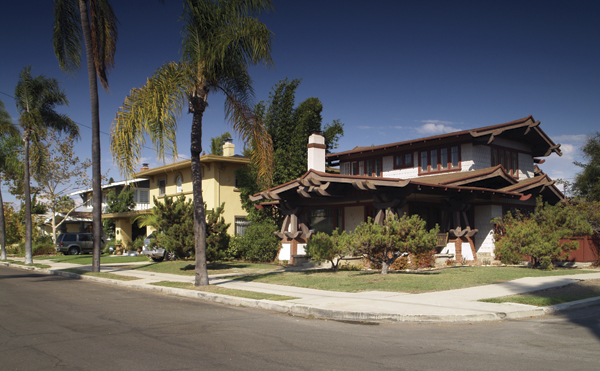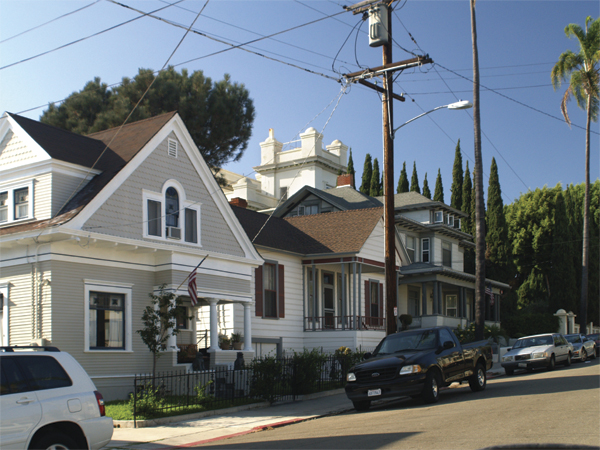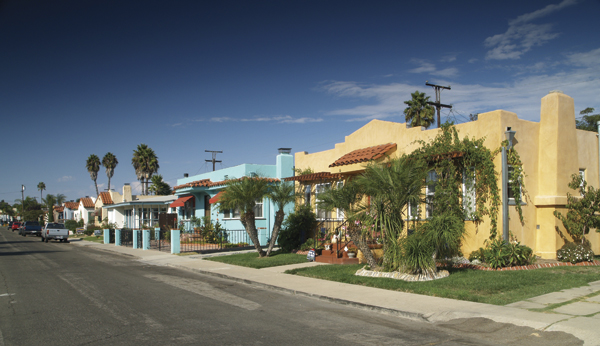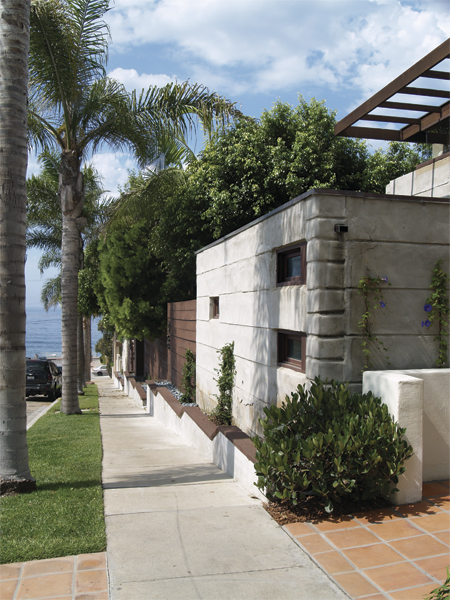|
The Impact of Historic Districts
on the character of our communities
By Julie Kolb
On a recent trip to Belgium, my family and I spent two days in Bruges. We didn't visit the city to enjoy a hamburger at McDonalds or to sleep in a Holiday Inn. Instead, we went to discover what makes Bruges unique.
A World Heritage Site, old Bruges looks much as it did in the 1500s with its cobblestone streets, canals, and ancient churches, commercial buildings, and residences. The fact that Bruges retains these medieval elements is a testament to the neglect the city suffered when it lost favor with local leaders. Bruges remained an outcast for more than three centuries. It wasn't until the 20th century that the medieval architecture was recognized as an asset worth preserving. In the decades since, thousands of tourists have been visiting the city and walking its cobblestone streets.

While North Park's 28th Street and Pershing Drive have not yet received designation as a historic district, residents of these streets have been working to have their neighborhood recognized for its wealth of architecture, built by such celebrated master builders as David Owen Dryden, and for its role in the growth of San Diego in the decade before World War I. The layout of these streets, the often grand Craftsman houses, and the more modest bungalows were designed to showcase the new neighborhood of North Park. Within the last decade and more, many of the houses on 28th Street and Pershing Drive have benefited from a renewed interest in Craftsman architecture as homeowners have invested money and time restoring their properties. Such efforts benefit not only the residents of these streets, but the houses and businesses nearby as the interest in restoration and redevelopment has spread to encompass much of North Park.
While old Bruges was initially preserved by neglect, historic communities within the United States, and more specifically San Diego, can't and shouldn't count on such a solution. "Although it is true that one reason National City retains such a large inventory of historic homes is because it was neglected, many of San Diego's historic buildings have been lost in the name of progress," points out Bruce Coons, Executive Director of Save Our Heritage Organisation.
Experienced preservationists know that historic districts are preserved and enhanced through small steps, carefully taken. - Erik Nelson
If neglect is not the answer, then the solution for ensuring preservation is the creation of historic districts. With the creation of historic districts come benefits, such as tourism, that a city and its citizens can profit from.
Beginning nearly 80 years ago, citizens in towns and cities in the U.S. recognized the need to protect their historic communities. In 1931, Charleston, SC, enacted laws to protect an area considered "old and historic." In 1937, the state of Louisiana created the Vieux Carre Commission to protect the French Quarter in New Orleans. Today, according to the National Park Service, there are more than 2,300 communities with laws that provide for the establishment of and protection of historic districts.

The neighborhood of Sherman Heights is a residential historic district located to the east of downtown San Diego. The community was named for Captain Matthew Sherman who purchased 160 acres in 1867 shortly after Alonzo Horton bought 960 acres of land along the waterfront. Within two years, Sherman had subdivided the land for development. Many houses in Sherman Heights were built between 1880s and 1920s and demonstrate the transition between the popular Victorian houses of the late 1800s to the Craftsman designs that emerged in early 20th century. The neighborhood is one of San Diego's oldest subdivisions as well as one of the original communities connected to downtown by streetcar. With its start as a solidly middle-class community, Sherman Heights later became known as a neighborhood of immigrants, providing housing for the various waves of immigrants who have made San Diego their home over the decades. Today this history is reflected in the diversity of its residents. Sherman Heights' success as a historic district is due in large part to the support of its residents who have invested the time and the effort to save the elements that define this neighborhood, its architecture, and its role in San Diego history.

Shirley Ann Place may be San Diego's smallest historic district. One block in length, most of the modest bungalows on this street were designed in the Spanish Colonial Revival style. Historically, this entire block of bungalows was built as a speculative housing tract by William B Melhorn, son of master builder Martin V. Melhorn, after World War I as people flocked to Southern California. Credit for the establishment of this historic district is due to the residents of this street who educated themselves on the work needed to receive such designation and on what they would accomplish by creating a historic district: its benefits, and its responsibilities.
So just what makes a community historic and thereby worthy of preservation? The National Park Service defines a historic district as "a collection of buildings, sites, and settings that share a common history, appearance, and special meaning in time and place."
For San Diegans, it should be easy to recognize some of our local historic districts based on this definition. The Gaslamp Quarter downtown is one such collection of buildings, sites, and their setting that share a common history and a special meaning. Old Town is another.
But it should be remembered that historic districts can be found beyond commercial zones. San Diego is home to several residential neighborhoods that have secured status as historic districts. The Fort Stockton Line Historic District and the Mission Hills Historic District are two recently established historic districts in Mission Hills. A historic district in the nascent stages of development is South Park. (See side bar in color block for more details.)
The responsibility for crafting laws to protect historic districts has been left to the states by the federal government. From there, local municipalities and their citizens must work together to develop preservation laws tailored to their region and its assets.
Erik Nelson, Senior Preservation Planner for the City of Fredericksburg, VA, says, "Experienced preservationists know that historic districts are preserved and enhanced through small steps, carefully taken. They know that the collective integrity of individual buildings imparts a distinct local identity, especially if they are complemented by street trees and landscaping, intact sidewalks, and flexible zoning that respects the historic geometry and function of existing neighborhoods... To achieve this goal, however, they must do more than rely on state and federal preservation laws. Historic district preservation usually occurs locally, beyond the scope of state and federal legislation."
Within our region, local government representatives, citizens, business owners, and neighborhood and community historic preservation groups, like Save Our Heritage Organisation, must work together to identify and create historic districts.
Fortunately, it appears that the City of San Diego may be ready to play an active role in making such goals a reality. According to Bruce Coons, the City claims it is much more focused on creating historic districts. "They said they really think historic districts are the way to preserve buildings," he says. But while he acknowledges the City has taken some steps toward this goal by appointing a staff member to focus on this effort, Coons also notes that he has not seen a lot of actual movement toward identifying and creating these new historic districts. "It looks like most of any new historic districts will still be neighborhood initiated," he says. "In reality, the City should be leading the way by initiating districts as well."
One of the difficulties faced by preservation advocates is that the work to establish historic districts often comes into conflict with real fiscal pressures facing many cities and counties. Ours is no exception. The California Office of Historic Preservation has identified these pressures as a threat: "Hamstrung by the fiscal limitations imposed by Proposition 13, local governments have developed and implemented land use policies that encourage massive growth and thus maximize the revenue stream from new taxes and fees."

Built in 1923, the Pueblo Ribera Courts in La Jolla is a twelve-unit residential complex designed by Rudolf M. Schindler. Schindler, who was born in Vienna in 1887, immigrated to Chicago and worked for Frank Lloyd Wright before relocating to Hollywood in 1921 to oversee a Wright project. With his pioneering use of poured concrete frames and his emphasis on eliminating barriers between the interior spaces and the world outside, Schindler has been recognized as an early innovator of Modern architecture. The Pueblo Ribera Courts is Schindler's only project built in San Diego. Using poured concrete, glass, and redwood structural elements, the complex was originally designed as inventive one-bedroom vacation rentals, economical in their use of space. The units are designed with a shared common wall while their u-shaped layout creates a private outdoor living space for each residence. At the streetscape, a long wall forms a division between the public life on the street and the private life of the spaces of the interior. Many of the Pueblo Ribera Courts units have been restored in recent years.
But the cost-benefit analysis for creating historic districts is much more complicated than simply tracking property tax collection or income generated through new construction. Such an effort fails to account for the many and varied benefits historic districts convey.
Perhaps the biggest benefit is historic districts maintain community character. A community is not simply a collection of buildings. As Nelson pointed out, it includes the streetscape, trees, and sidewalks. Community character encompasses the deliberate and careful layout of roadways and pedestrian walkways, and it is marked by the common threads of design and historical significance that unite these elements. No one would confuse a visit to the Gaslamp Quarter with a trip to a strip mall. Residents of Burlingame don't mistake their streets for the streets of Rancho Peñasquitos.
"We talk a lot about heritage tourism," Coons points out, "And more than 81 percent of people who visit San Diego surveyed say they come to visit and to stay in these historic areas."
For opponents, one argument against preservation is that every home or commercial building within a historic district does not qualify as a historic property. In fact, San Diego's own Historical Resources Board notes, "Many times, buildings that are not significant in themselves become important when viewed as part of a larger collection."
The need to identify and to establish historic districts is ongoing, as are the benefits that result from such designations. As the City of San Diego considers changes to the way individual properties are historically designated under the Mills Act, Save Our Heritage Organisation is moving forward with efforts to establish a template for preserving whole communities. The benefits of preservation conveyed to a community are many and varied. When citizens value the myriad features that make a community unique or ground it in a specific place and time historically, we are called upon to take action to preserve that community and to reap the rewards of such an effort.
Julie Kolb writes a regular architectural feature in the North Park News, and was recently published in American Bungalow. Julie became interested in historic preservation while working for SOHO and has carried that into her writing career.
All photos by Sandé Lollis
Recently, residents of historic neighborhoods have been asking SOHO to find a way to help district nominations happen for all of San Diego. A daunting request to be sure, and some have even suggested we do it without asking our members or residents who would benefit from it most for donations to assist the effort! Well, since suspending all reality didn't seem a feasible option we instead have come up with an idea to create a historic district template for assisting community-driven applications.
The idea is to engage and enlist each community to perform the primary work needed to create the nomination package for a historic district and SOHO would create a template of tools to be utilized by every community. These tools would include SOHO as part of community Q&A workshops to help answer concerns and to debunk the many myths promoted by those whose best interest is not served by communities retaining their character, charm, and quality of life value.
In order to create this template we decided the best way would be to begin by doing an actual district nomination and work our way through every aspect, and every detail of the community-driven district nomination.
We have chosen the neighborhood of South Park. The choice was determined for a variety of reasons, one is that the neighbors started a historic district nomination in the 1990's, spearheaded by Beth Montes, Bonnie Poppe and Erik Hanson. They gathered much vital information, but after a certain point were stopped by a lack of dedicated volunteer help and some city issues that began to create roadblocks to success.
Times have changed and with the help of interns, neighborhood volunteers, and the city who is now in favor of districts, and by retaining a professional program coordinator we are taking up that nomination package again. We will be enlisting some of the same people who began it along with newly engaged South Park residents and hopefully some sponsorships from local businesses as well, all who would benefit greatly from district status to finally, after more than a decade, bring a South Park historic district nomination to the city for consideration.
The program coordinator along with SOHO staff will design a template toolbox that would be fully accessible online at no cost to allow other San Diego communities to self-guide themselves through the arduous process.
This will prove helpful to areas that are intact but less economically advantaged than a South Park or a Mission Hills; they will find that this template will help level the playing field for them.
City staff for the Historical Resources Board is currently defining guidelines for working with communities. They know that the city can see savings of manpower, expense, and expediency if communities conduct the research and create district nomination packages themselves in a professional manner.
Now, for that reality check: SOHO does not have the funds for such a program and we are now asking for donations from everyone to help get this program started. Residents and businesses of the test neighborhood of South Park will be asked to contribute of course, without their contributions it will not happen, but we ask that anyone interested in seeing multiple districts throughout the county and city of San Diego consider making a donation. The big picture is significant, we could save years of fighting each individual building's status and along the way show the city how serious its citizens are about the importance of San Diego's architectural and cultural heritage.
- Alana Coons |
|
MORE FROM THIS ISSUE
From the Editor
2008 Most Endangered List of Historic Resources
Character Matters
Smart Growth - or is it?
The Impact of Historic Districts
Washington Didn't Sleep Here
How to Research Your House
Preserving Community Character
Behind the Tuscany Craze
2008 People In Preservation Award Winners
Preservation Community
Reflections
Annual Financial Report
Book Review - Working Windows
Sherlock Homes
Speakers Bureau Forming
Lost San Diego
Strength in Numbers
Advertisements
DOWNLOAD full magazine as pdf (16mb)
|







